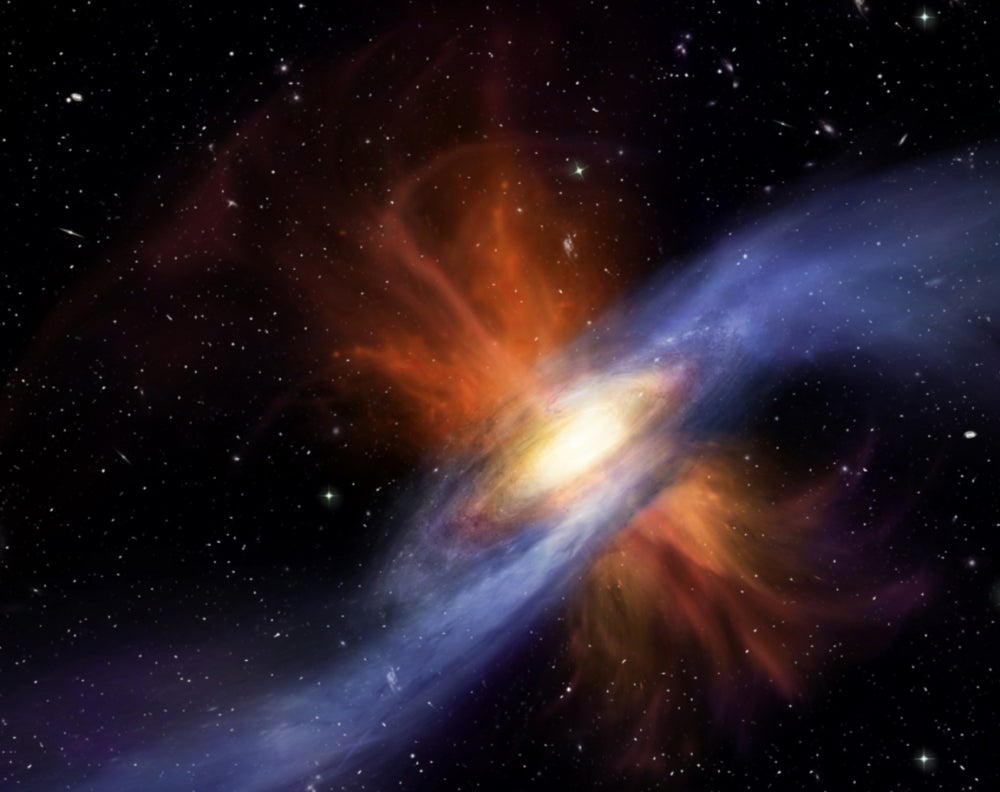
Faint Galactic Halos


Take a look at any galaxy in the universe through a telescope or in pictures captured by observatories and you might think you have a good idea of its shape.
Think again — roughly half of a galaxy’s matter is invisible. But scientists have since discovered this missing mass in halos of cool gas surrounding galaxies. Understanding their dynamics, however, has remained an open question.
Now a team of astronomers led by UC Santa Barbara Professor Crystal Martin and graduate student Stephanie Ho has released a paper investigating how these halos interact with the rest of their galaxies. The study appears in The Astrophysical Journal.
“When you look at galaxies, you see light and that’s what grabs your attention, and you think that’s where the stuff is,” said Martin. “What’s interesting to me is that most of the normal material associated with a galaxy is not luminous at all.”
Astronomers can measure the total mass of a galaxy by looking at the galaxy’s movement and rotation. But this doesn’t separate normal from dark matter. Fortunately, scientists have good measurements of the ratio of these two on the cosmic scale. Around 84% of the universe’s mass is dark matter, and 16% is conventional matter — made up of protons, electrons, neutrons, and their cousins. With this knowledge, researchers figured out that roughly half of galaxies’ normal matter was nowhere to be seen.
A lot of prior work focused on finding this missing material, Martin explained. “Our study was about trying to measure how the gas in the halo was moving,” she said.
To find the missing matter, astronomers needed something incredibly bright shining through the diffuse clouds. Some galaxies have extremely active black holes in their centers called quasars, which send out beacons of radiation into the universe and are bright enough to help scientists spot the dilute gas halos.
As quasar light travels through these galactic halos, the dust and gas absorb specific wavelengths of light based on its composition. The research team pieced together the distribution and composition of this missing matter by comparing the light spectra from these shrouded quasars to those they can see directly.
“This method gives you a lot of information, but it’s all along one sight-line,” said Martin. And few galaxies have more than one quasar behind them.
To circumvent this challenge, Martin and her colleagues combined the data from 50 similar galaxies, each with a single quasar behind it. This produced a model of one average galaxy with fifty quasars behind it, plenty of coverage to get an accurate picture of the system.
Now that the researchers knew the size of the halo, and what it was made of, they wanted to investigate how this gas behaved. Fortunately, the motion of the halo gas shifts the spectra in predictable ways: matter moving toward us produces bluer spectra, and receding material is redder. This is the same effect as the change in pitch you hear in an ambulance siren as it passes you on the road.
Martin and Ho discovered that these gaseous halos rotated along with the rest of the galaxy, but not quite fast enough to keep material from slowly falling in. What’s more, supernovae within the galaxy had ejected material back out, especially perpendicular to the galactic plane.
This dynamic creates a circulation, where gas falls into the galaxy and nurtures new stars, which fuse light elements into heavier ones. Eventually some of this material, now enriched with heavier elements, is thrown from the galaxy, where it can begin the cycle over again. In fact, astronomers believe that this circulation dictates the composition of material that forms new stars. What’s more, stars enriched with heavier elements appear to be more likely to form planetary systems than those made of only light elements, according to Martin.
“This circulation drives the galactic ecosystem,” she said.
In addition to shedding light on planetary systems like our own, the study also illuminates the workings of our galaxy. Most of the 50 galaxies in the study were similar to how the Milky Way looked around 250 million years ago, a fairly short amount of time on a cosmic scale. This is also about as much time as our galaxy takes to make a single revolution, Martin explained, which is the minimum timescale for any significant galactic change.
Martin and Ho plan to investigate how the rate of gas falling back into a galaxy compares to the rate of star formation. This will provide a better understanding of the evolution of star-forming galaxies over billion-year timeframes. Martin is interested in whether galaxies with more star formation have more disturbed halo gas above and below the disk plane, as would be expected with more supernovae.



